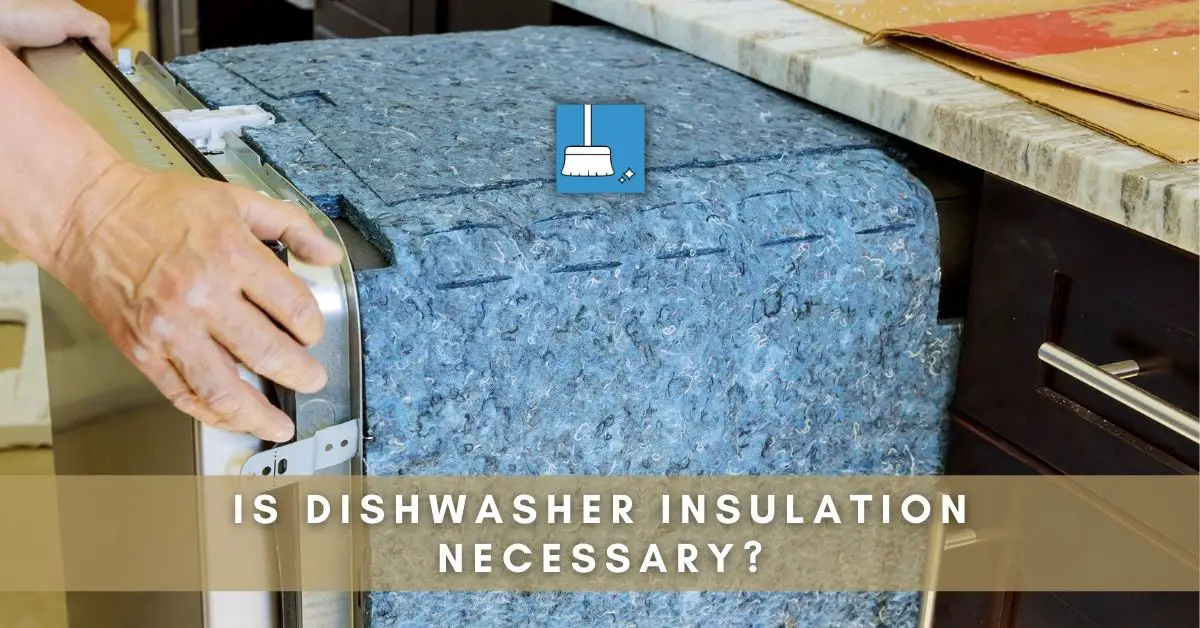When a dishwasher is on, it is normal to hear some whining, swishing, clicking, humming, and snapping sounds coming from it but when the noise starts to disrupt your home environment, it might be time to get an insulator.
Even though dishwashers are usually hard metal boxes, they usually have many soft spots inside and insulators ensure that those parts stay protected.
This article will discuss how necessary it is to have insulation around your dishwasher and how to install insulation yourself.
Is Dishwasher Insulation Necessary?
A dishwasher Insulation is not an absolute necessity for the dishwasher but it can help to reduce noise, protect the machine from heat and steam, and reduce the risk of damage to adjoining cabinets and countertop.
Insulators are materials that do not readily allow the passage of sound and heat through them. Many owners get dishwasher insulation to deal with or prevent certain problems.
Despite the fact that insulators are not a necessary part of the normal functioning of a dishwasher, the following reasons make it necessary for you to have insulation for the dishwasher:
1- Lowers Damage (to adjoining things) Risk
Insulation stops the dishwasher from vibrating when it is operational. For a dishwasher with no insulation or insulation that has deteriorated, the counters will shake as the machine operates.
This may end up causing damage to the surrounding cabinets and appliances or moving things off the counters.
2- Protects the Dishwasher Itself
When the dishwasher rattles during a cycle, it may be getting knocked between the cabinets, especially if your dishwasher is not screwed in. This may loosen some of the dishwasher elements and make it not operate at optimum levels.
Insulation enables the dishwasher to remain still even during vigorous cycles, hence preventing damage.
3- Saves You from the Irritating Noise
Insulation reduces the noise made by the moving parts of a dishwasher. Dishwashers make between 70-80 decibels of noise as they operate. This could include the noise of the machine spraying the dishes and also the sound of gurgling as the dishwasher is draining.
Insulation reduces the noise to 60 or even 50 decibels. This ensures that even when it is on, the sound it makes goes unnoticed.
This means that the family can have quiet time or casual conversations even when the dishwasher is on.
4- You are Saved from Getting Burned
Dishwashers use steaming hot water in some of the cycles when washing dishes. When it is running hot water, the dishwasher feels hot to the touch, especially if the machine has no insulation.
Insulation acts as a barrier to heat flow, hence all the heat remains in the machine and is not released in the environment meaning you can touch it or bump into it without getting burned.
5- Protects the Machine from Heat & Steam
Insulation also keeps water and steam from escaping the machine and damaging appliances, flooring, or the cabinets next to it (especially if they are made from wood).
When steam escapes the machine, the condensation is caught on the insulation instead of seeping into the kitchen cabinets.
What Is Dishwasher Insulation Made Of?
Insulation is commonly made of fiberglass, foam, or felt, and more high-end insulation is made of ceramic fiber. Other types of insulation are moving blankets, polystyrene and low-end insulation being made of cotton (although this is a very poor insulator).
1- Foam Insulation
Foam insulation prevents the circulation of hot and cold air and also muffles the sound of noisy appliances. It also has an R-value of at least 4 (R-value is the resistance to heat flow that material has. The higher the R-value, the more efficient the insulator).
Foam insulators are installed in a pressurized spray which gets into hard-to-reach places. Once sprayed, it expands and then hardens within a few minutes. It does not need glue or pins to be attached since it is self-adhesive.
The foam reduces noise and also ensures that water does not damage the appliance as well as surrounding spaces since it is non-absorbent.
For jobs such as dishwasher insulation, smaller kits, with less pressure, are used since having the regular high-pressure foam may end up cracking your counter or spilling over into unwanted spaces.
2- Felt
Felt is typically made from sheep’s wool and other animal hair. It is combed into sheets, steamed then compressed to form the insulation. It has an R-value of between 3.5 to 4.3 per square inch of thickness, making it a good thermal insulator.
The reason that felt is a good insulating material is because it manages moisture and can absorb up to 3 times its weight in water without creating a favorable environment for the growth of mold. It is also very good at sound absorption, taking care of your noise muffling needs.
Felt also offers perks such as improving the air quality in your home by bonding toxins in the air with amino acids in the wool.
Felt is however quite expensive as it uses 100% wool to make the insulation material.
3- Fiberglass
Fiberglass is made of extremely thin glass fibers bound to plastic to form an insulation material. It slows the spread of heat, cold, and sound through it, and due to its pocket-friendly price, it is a good option for when you want to do the installation yourself.
It has an R-value of 2.2-4.3 per inch of thickness, which makes it a good, easily accessible insulator.
Fiberglass comes with its own set of problems. This includes its tendency to trap allergens such as dust and when it is disturbed, it releases particles that can be inhaled by people and cause an allergic reaction or even a nosebleed.
CAUTION: When working with fiberglass, one has to put on gloves and masks since the small particles can get lodged into the skin and cause itchiness or a rash.
What Kind of Insulation Goes around a Dishwasher?
The type of insulation that goes around a dishwasher is usually in form of a blanket, pads, or mats. This is usually the easiest way of installing insulation especially if it is a fitted appliance.
The blankets wrap around the dishwasher or inside the cabinet space (or both) to keep the appliance insulated.
Dishwasher Didn’t Come with Insulation! (What to Do?)
Sometimes, your dishwasher does not come with insulation, or people mistake the insulation in the box for packing material. You can always buy and install your own insulation material depending on the size of the dishwasher you have.
An important element to note is the amount of extra room available in the cabinet space. This is because fitted dishwashers usually slide into a designated space, and it is usually a very tight squeeze to fit in bulky insulation material.
To install your own insulation, you need to:
Step 1: Disconnect the Wiring at the Back of the Dishwasher
The wiring includes piping and electrical systems. For the electrical connections, shut down the electrical flow to the dishwasher on the circuit board; then unplug the wiring from the dishwasher.
Disconnect the water flow from the dishwasher. Twist the valve shut. If you have a regular setup, you’ll find the valve under the sink.
Place a towel underneath the dishwasher when disconnecting the waterpipe because any water still in the pipe will drain out.
Disconnect the drainage hose. For a regular setup, the drainage will be attached to the bottom of the sink.
Step 2: Unscrew the Dishwasher from the Cabinet Space
If your dishwasher is screwed into the cabinet space, you’ll find the screws either at the top edge of the dishwasher, the bottom, or the side (you’ll see them when you pull down the door).
Unscrew the dishwasher using a screwdriver. Ensure you place the screws in a safe place to screw back on later.
Step 3: Retract the Front Legs of the Dishwasher
Retract the front legs by twisting them with a wrench or pliers. This will lower the dishwasher and you can wiggle it out of its spot.
Step 4: Pull Out the Dishwasher
Place a rag or cardboard underneath the dishwasher to avoid scratching your floor as you drag the dishwasher out of its space.
Ensure that when you remove the dishwasher from its space underneath the counter, you hold onto all the piping and electrical wires to avoid damaging them.
Step 5: Install the New Insulation
You’ll now be able to see the old insulation on the dishwasher. Feel free to cut that away before installing the new insulation. You can either nail the new insulation in place, glue it or tape it to the dishwasher.
Step 6: Place the Dishwasher Back and Reconnect Everything
Put the dishwasher back in its place and reattach the pipes and electrical wiring. Use pliers or a wrench to extend your dishwasher’s front legs (ensure that they are level).
Use the screwdriver to screw back the dishwasher to its cabinet space.
Step 7: Test the Dishwashers’ Functions
Test the electrical and the water system to ensure that everything runs smoothly and nothing is leaking.
Dishwasher Insulation Alternatives
1- You may want an alternative to traditional insulation materials due to reasons such as wanting to go green or having an allergy to the traditional material.
2- As an alternative to foam felt or fiberglass insulation, one can use moving blankets, sound deadening mats, or a new quieter dishwasher (if you can afford it).
3- You can use mineral wood (which is non-combustible) or cellulose (which is one of the most eco-friendly and compact insulation materials there is).
4- A pricier option would be to purchase aerogel insulation, most commonly Pyrogel XT. Aerogel is one of the best insulators in the world, having only become accessible to the public recently.
It requires 50-80% less thickness than other materials to effectively insulate, making it a good option if you are tight on space.
5- Using a material like cotton, hemp or straw is a good option but should be your last resort. As dishwasher insulation materials, they will do a poor job at absorbing heat and will eventually start to rot and produce a bad odor since they are organic.
When deciding on alternative insulation, ensure that whichever material you settle on is heat resistant and non-absorbent.
When Do You Replace Dishwasher Insulation?
When you start hearing your dishwasher making more noise than usual or getting uncomfortably warm as it functions, it might be an indication that your old insulation had been worn out and you need to install a new one.
However, check the functioning of your dishwasher to make sure that the problem is not coming from a malfunction in the dishwasher. Consider having a professional check your dishwasher first before buying insulation.
When going for new insulation, you can choose one that can take more heat. Many can take constant direct heat of up to 1300 F, which makes them heat resistant. They can also be compressed to make them more easily installed in smaller spaces.
Look for the ones that have organic binders as there will be no smelly burnout when exposed to heat. This will ensure that even when exposed to water or extreme heat from the dishwasher, it will not start to rot and stink up your living space.
This kind of a blanket can be installed with fasteners such as pins and bolts and can also be attached to your dishwasher using ceramic adhesive or tape.
Final Thoughts!
Insulation around a dishwasher is one of those things where its presence will not be noticed but its absence will be felt.
Ensure that you always consider the dimensions of your dishwasher and the available space before purchasing insulation.
Having insulation around a dishwasher makes for a better dishwasher experience for owners.





